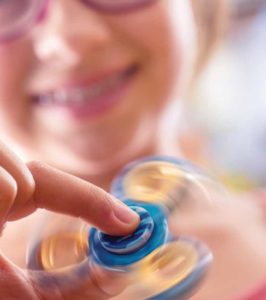
Fidget spinners are currently all the rage in most households, schools and preschools in New Zealand. With some schools banning them and others embracing them, what is the impact of these toys on children’s learning and development? Do our children benefit from such a thing, or are these novelties just too hard to manage in a classroom?
Many schools have now banned fidget spinners, and some like Palmerston North’s Roslyn School, are using them as teaching tools. So how do we know if they are beneficial or if they are a bust? Taking a look at how children learn helps us understand if the spinners have a role in the classroom.
We all learn through different ways. These learning styles are separated into the broad groups of: visual, auditory and kinesthetic. Visual means we learn through seeing, auditory means we learn mostly through listening, and kinesthetic means we learn mostly through moving.
In fact, some argue that all learning is based in movement from the time we are in utero until the time we die. To see, our eyes move and focus, our ear drums move when we hear and our body is in constant movement as we take information through all of our other senses. This is the one aspect of learning that does not alter as we age we just become more sophisticated at doing it.
As individuals, we will each be more dominant in one of these styles of learning. Visual and kinesthetic are the more prominent learning styles with auditory being the least. (Are you now questioning why so much of our educational system is based around listening? You are right to wonder, but that is another topic!)
Fidget spinners are the latest craze but they are not new in terms of teaching aids in the classroom. For decades teachers have allowed highly tactile, kinesthetic children to utilize small toys and manipulatives to hold quietly, which in turn, helped increase their listening capacity and focus on tasks. These have mostly been used for children with special educational needs, particularly Autism and ADHD.
Yet, even now, big companies are utilising methods such as stress balls, walking meetings and a range of workspaces to benefit business productivity through movement! Even as adults, we are learning that movement helps us focus and provide equal learning.
As a mum of four, three of which are boys, I fully understand the need for children to move when learning – do boys ever sit still? However, also, as a teacher I completely understand how distracting it can be to other children when some children are fidgeting in the classroom! So how do we best meet each child’s needs, and also use their learning styles to shape learning experiences?
So do fidget spinners need to be banned? I don’t think so. I think that clever teachers can maximise them for benefits to both children and teachers. Does this take time and effort? Absolutely! However if children are showing such an interest in something, it only makes sense to use that interest to teach the curriculum. If we are trying to raise children to love learning, the question we need to ask is: Why do we continually take away the things that they most love, such as fields, sports, arts, a range of games, and now fidget spinners?
If schools are open to finding ways to use this interest, the inquiry learning method has the potential to do just that. It takes real life problems and interests and researches, teaches and creates methods of learning for that interest. Using inquiry in the classroom is one way fidget spinners can move out of the ‘toy craze’ category and into the teaching tool category.
This is what we see in the example of Roslyn School. Suggestions for schools could be to: adopt an “if you make your own you can have one” policy, make them as part of the curriculum, or set boundaries around their use, such as only in particular lessons, or at particular times in the classroom.
Like any other item in a classroom fidget spinners must be used within the rules of the classroom and teachers can maximise their use to reward and change behaviour. This creates a win-win for both students and teachers. Children are born to move and through movement all learning happens. Fidgeting is just one way that children can expel pent up energy so that they have the control to focus on learning.
